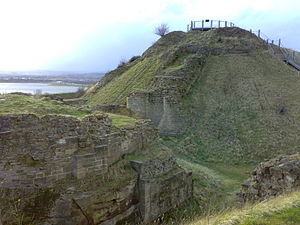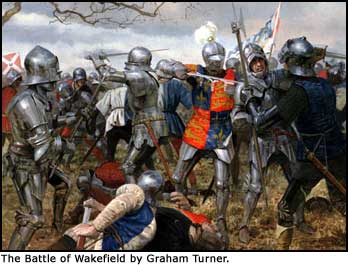The Battle of Wakefield, on December 30 1460, was a pivotal clash in the Wars of the Roses that resulted in the deaths of key Yorkist commanders and serves as the opening for Loyalty Binds Me.
BACKGROUND
Richard Plantagenet, 3rd Duke of York, family patriarch and Lord Protector of England, moved north from London on December 9th 1460 to counter the growing Lancastrian forces. York was joined by his son, Edmund, Earl of Rutland, and his brother-in-law, Richard Neville, Earl of Salisbury. London was guarded by Salisbury's son, Richard Neville, Earl of Warwick, and York's eldest son, Edward, Earl of March, was dispatched to Wales to quell Lancastrian support.
York's progress north was slowed by widespread flooding and this allowed the Lancastrians forces to grow in the north. The northern Lancastrian army were led by Henry Percy, Earl of Northumberland, Lord John Clifford and Lord Thomas Ros. Reinforcements came from the West Country with men commanded by Henry Beauford, Duke of Somerset, and Thomas Courtenay, Earl of Devon, to amass an army of over 15,000 men gathered around Kingston-upon-Hull. A substantial amount encamped at Pontefract and began pillaging York's and Salisbury's nearby estates. Northumberland, Clifford and Somerset were ready to exact revenge on those who had killed their fathers five years previously at the First Battle of St. Albans.
York's force of 8,000 men arrived in Wakefield on 21 December after earlier skirmishes in Nottinghamshire. The gates of Wakefield were closed to York and he took residence nearby at Sandal Castle. The Lancastrian army encircled the castle and a Christmas truce was agreed upon with a battle commencing on the Feast of Epiphany, January 6. York sent word to his son in Wales to bring reinforcements, whilst his men at Sandal Castle grew hungry after depleting their provisions over Christmas. York decided to send out a foraging party on December 30 to get more provisions but they never returned.
BATTLE
York took his men down from Sandal Castle later that day and were soon ambushed on Wakefield Green. As York
 |
| Ruins of Sandal Castle |
York's army was surrounded and destroyed with the dead numbering 2,500 Yorkist and 200 Lancastrians. York was killed in the battle but instructed his son to flee to Wales before dying. Rutland was soon captured and killed on Wakefield Bridge. Clifford cried out “By God’s blood, thy father slew mine and so will I do thee and thy kin” as he stabbed Rutland
The heads of York, Rutland and Salisbury were later put on spikes on Micklegate Bar, the western gate into the city of York. The Duke of York was ridiculed with a a paper crown on his head and a sign around his spike that stated "Let York overlook the town of York."
Wakefield brought the end of York's claim to the throne but this was quickly taken up by his son, and future King, Edward VI. Wakefield set a grisly precedent in that after every following battle in the Wars of
the Roses, the victorious side would eliminate any opposing leaders, making the
struggle more bitter and revenge driven.

No comments:
Post a Comment